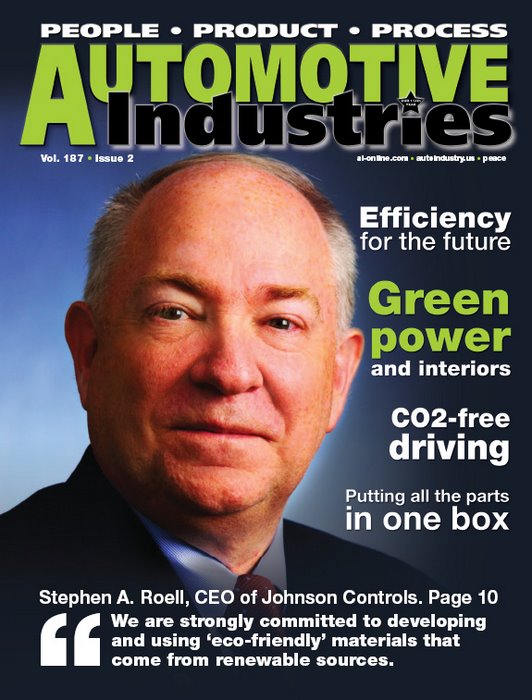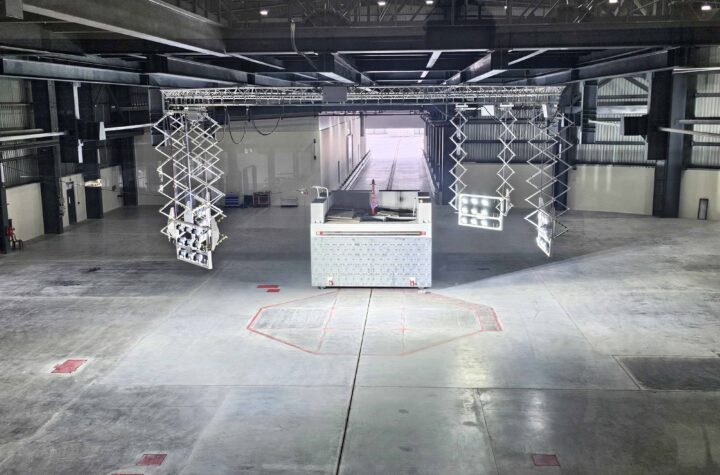
Environmental concerns provide both challenges and opportunities for the auto industry.
Showcasing some of the latest technology is Johnson Controls, with its I3 concept car. The vehicle targets the fast-growing, crossover-utility-vehicle or CUV segment, and addresses the growing interest in plug-in hybrid electric vehicles (PHEVs).
“Our goal is to create a smart environment that meets consumer demands for vehicle flexibility, connectivity, comfort and sustainability,” says Jeff Williams, group vice president and general manager, North America for the automotive experience business of Johnson Controls.
The company’s development of energy storage for hybrid and electric vehicles is a joint venture with Saft Advanced Power Solutions, an advanced energy storage solutions provider with extensive Li-ion battery expertise. The lithium-ion battery from Johnson Controls-Saft weighs 50% less than nickel-metal hydride batteries and takes up one-third less space. When plugged into the electric grid, the PHEV drive train can yield fuel economy performance that is nearly double that of conventional drive trains. Nearly all of the Johnson Controls products and innovations included in the I3 concept car are available for production now.
In June, Johnson Controls-Saft was selected by Ford Motor Company to supply lithium-ion batteries for a test fleet of PHEVs. The company is also supplying lithium-ion batteries for the 2009 Mercedes Benz S Class and another vehicle which has not yet been announced. Johnson Controls-Saft recently announced contracts with Chery of China, Shanghai Automotive Industry Corporation (SAIC), and several other OEMs. Earlier this year, the company opened the world’s first lithium-ion production facility in Nersac, France.
Support for the research has come from the US Advanced Battery Consortium or USABC. It has contracted Johnson Controls-Saft to continue developmental efforts regarding lithium-ion technology for automotive applications. The funding, provided by the US Department of Energy through the USABC as part of the FreedomCAR and Fuel Partnership project, enables Johnson Controls-Saft to continue in-depth research on cell performance and systems development. The USABC is a consortium of the United States Council for Automotive Research (USCAR), an organization comprised of DaimlerChrysler Corporation, Ford Motor Company and General Motors Corporation.
Automotive Industries connected with Stephen A. Roell, who became CEO of Johnson Controls in October 2007, and Dr. Beda Bolzenius, who joined Johnson Controls in 2004 and became president of its automotive experience business in August 2006.
AI: Is going green the best way to achieve growth for auto companies?
Bolzenius: Consumers are becoming increasingly aware of green technologies and are starting to demand more environmentally-friendly products in their homes and workplaces. This trend is also reaching the vehicle market. Automakers have been listening to the feedback and addressing consumer needs through cars that get better fuel economy, have lower emissions, and include natural materials. We work with customers using a process called Value Product Planning (VPP) to help them decide what their targeted consumers will value most in a vehicle. We leverage our extensive consumer research to compare possible interior options and predict market demand. In addition, we focus on ensuring our global footprint is appropriately matched to our customers’ production needs.
AI: Johnson Controls hopes to boost revenues to US$50-billion in five years – where will the growth come from?
Roell: We’re fortunate to be a global, financially strong, diversified company, so we see many different opportunities for growth. Our automotive interiors business will play a big part. We’re also very focused on growing the business in China, India, Russia and other emerging markets to take advantage of the rapid growth those economies.
Automotive batteries and advanced energy storage solutions – especially batteries for hybrid vehicles – also represent a tremendous growth opportunity. We see continued expansion of the SLI (starting, lighting, ignition) business in emerging markets and global growth in hybrids and PHEVs.
AI: What contribution will green technologies make?
Roell: It will be a balance, but certainly we expect our focus on sustainability to help drive that growth. All three of our businesses are linked to creating green – as well as safe and comfortable – products and environments. We are strongly committed to developing and using “eco-friendly” materials that come from renewable sources. Bio-materials such as soy can help cut the industry’s reliance on petroleum-based products.
We’re also looking at combining economic and ecological objectives with our FaserTec seat pads, made out of coconut fiber and latex. Compared to conventional manufacturing, FaserTec production requires fewer process steps and materials. The pads are easier to recycle and the process reduces the overall volume of emissions.
In addition to our relatively new leadership in lithium-ion technology, our power solutions business has been working for over 15 years on developing nickel metal hydride batteries for hybrid vehicles.
AI: What impact has the I3 concept had?
Bolzenius: We demonstrated the I3 concept at the IAA in Frankfurt, Germany and the North American International Auto Show in Detroit, Michigan. We’ve also shown it separately to several automakers and customers – and the response has been very positive.
AI: Which technologies used in I3 are particularly relevant?
Bolzenius: Our customers have been very interested in our seating innovations – the Slim Seat and the invisible rear-seat row. They are also interested in our two-color RIM alpha technology which can create multi-colored parts in a single processing step.
Ergonomics and driver safety also play an important role. We presented a hybrid instrument cluster in our concept car that ensures the best possible human-machine interface by reducing the information processing and driver distraction time. And our riACT head restraint improves the anti-whiplash protection offered by vehicle head restraints.
Other positive responses have come from our technologies that are linking people to their vehicles: for example, our mobile device gateway which links electronic devices – such as mobile phones, navigation devices and digital music (MP3) players – to the vehicle, and touch screen displays that feature all conventional controls in a single panel, reducing the need for about 20 mechanical buttons and knobs.
AI: What potential do lithium-ion batteries have compared to nickel-metal-hydride units?
Roell: They offer major advantages in terms of power generation, size, weight, cycle life and cost – weighing up to 50% less and taking up one-third less space.
AI: What is your strategy to expand in developing economies?
Roell: It’s been our practice over the last decade to pursue joint ventures with local suppliers to provide global expertise in seating, interiors, and electronic components. We focus on enhancing our customer / partner relationships, and try to leverage our footprint to grow with the OEMs as they build their businesses in these countries. In the power solutions business, we’re expanding our manufacturing and distribution capabilities. We can also help emerging markets develop a “closed loop” system for lead reclamation and battery recycling.
AI: How is this strategy different from that used to boost revenues in developed countries?
Roell: In the more mature markets automotive industry customer relationships are typically longer, broader – involving more people in both Johnson Controls and in the customer organizations – and therefore are somewhat more complex.
In these markets, we’re continuing to build our relationships with customers on an ongoing basis. We leverage our scale, manage our footprint, and use our “best business practice” approach to drive operational excellence and reduce overheads, streamline our product and process portfolio, optimize capacity, and strengthen technical competence and product design capabilities to ensure continued competitiveness. That’s largely true for both the automotive interiors business and the power solutions business. This has required us to become adept in supporting our aftermarket customers through marketing, category management and other merchandising programs.









More Stories
DuPont materials science advances next generation of EV batteries at The Battery Show
Cybord warns of dangers of the stability illusion
How Modern Power Management Enhances Connected Fleet Tech